
Puget Sound is a sound on the northwestern coast of the U.S. state of Washington. It is a complex estuarine system of interconnected marine waterways and basins. A part of the Salish Sea, Puget Sound has one major and two minor connections to the Strait of Juan de Fuca, which in turn connects to the open Pacific Ocean. The major connection is Admiralty Inlet; the minor connections are Deception Pass and the Swinomish Channel.

Clam is a common name for several kinds of bivalve molluscs. The word is often applied only to those that are edible and live as infauna, spending most of their lives halfway buried in the sand of the seafloor or riverbeds. Clams have two shells of equal size connected by two adductor muscles and have a powerful burrowing foot. They live in both freshwater and marine environments; in salt water they prefer to burrow down into the mud and the turbidity of the water required varies with species and location; the greatest diversity of these is in North America.

The Pacific geoduck is a species of very large saltwater clam in the family Hiatellidae. The common name is derived from the Lushootseed name, gʷidəq.
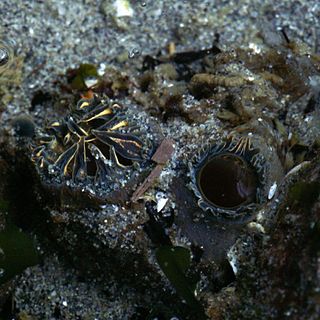
Tresus capax is a species of saltwater clam, marine bivalve mollusk, common name the fat gaper, in the family Mactridae. It also shares the common name horse clam with Tresus nuttallii a species which is similar in morphology and lifestyle. Both species are somewhat similar to the geoduck, though smaller, with shells up to eight inches long (20 cm), weight to 3–4 lb (1.4–1.8 kg).

Aldabrachelys is genus of giant tortoises, including the Aldabra giant tortoise native to the Seychelles, as well as two extinct species, Aldabrachelys abrupta and Aldabrachelys grandidieri known from Madagascar.
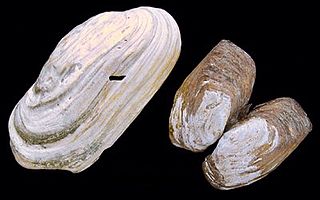
Hiatellidae is a taxonomic family of saltwater clams, marine bivalve molluscs. This family is placed in the order Adapedonta.

Hiatella arctica, known as the wrinkled rock-borer, the arctic hiatella or the arctic saxicave, is a species of saltwater clam, a marine bivalve mollusc in the family Hiatellidae. The white shell of this mollusc is thick and more or less rectangular, but generally irregular in shape. It is up to 45 mm long.
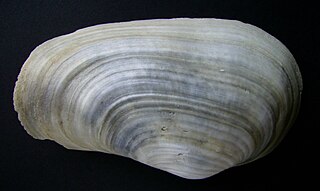
Panopea is a genus of large marine bivalve molluscs or clams in the family Hiatellidae. There are 10 described species in Panopea. Many of them are known under the common name "geoduck".

Panopea zelandica, commonly known as the deepwater clam or New Zealand geoduck, is a large species of marine bivalve mollusc in the Panopea (geoduck) genus of the family Hiatellidae. It is also sometimes called a king clam, or a gaper – in reference to the shell not being closed at either end.
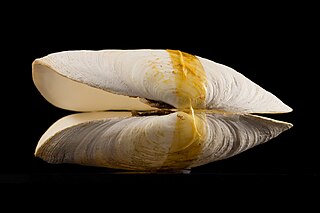
Panopea smithae is a species of large marine bivalve mollusc in the Panopea (geoduck) genus of the family Hiatellidae, found in the waters surrounding New Zealand. While its relative Panopea zelandica lives in shallow waters, P. smithae lives in deeper waters, ranging from deep harbours to the outer continental shelf.

Amanita abrupta, commonly known as the American abrupt-bulbed amanita or the American abrupt-bulbed lepidella, is a possibly toxic species of fungus in the family Amanitaceae. Named for the characteristic shape of its fruit bodies, this white Amanita has a slender stem, a cap covered with conical white warts, and an "abruptly enlarged" swollen base. This terrestrial species grows in mixed woods in eastern North America and eastern Asia, where it is thought to exist in a mycorrhizal relationship with a variety of both coniferous and deciduous tree species.

Tresus nuttallii, common name the Pacific gaper, is a species of saltwater clam, a marine bivalve mollusk in the family Mactridae. It also shares the common name horse clam with Tresus capax, a species which is similar in morphology and lifestyle. Both species are somewhat similar to the Geoduck, though smaller, with shells up to eight inches long (20 cm), weight to 3–4 lb (1.4–1.8 kg).
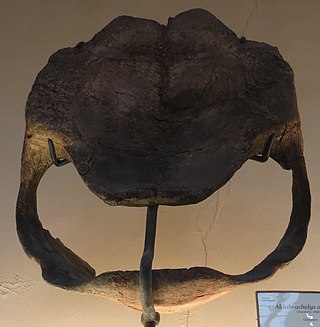
Aldabrachelys abrupta, the abrupt giant tortoise, is an extinct species of giant tortoise that was endemic to Madagascar.

Geoduck aquaculture or geoduck farming is the practice of cultivating geoducks for human consumption. The geoduck is a large edible saltwater clam, a marine bivalve mollusk, that is native to the Pacific Northwest.
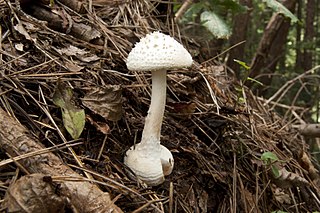
Amanita sphaerobulbosa, commonly known as the Asian abrupt-bulbed Lepidella, is a species of agaric fungus in the family Amanitaceae. First described by mycologist Tsuguo Hongo in 1969, it is found in Southern Asia.

Autoba abrupta is a species of moth of the family Erebidae. It is found in Papua New Guinea, Thailand, and Australia. The species is largely used by the name Eublemma abrupta in Indian and Sri Lankan texts.

Aldabrachelys grandidieri, or Grandidier's giant tortoise, is an extinct species of tortoise that was endemic to Madagascar. Mitochondrial DNA extracted from subfossil bone confirm that it is a distinct species.
Panopea dockensis is an extinct species of marine bivalve mollusc from the Pliocene–Pleistocene Waccamaw Formation of North Carolina. It was a close relative of the well-known Pacific geoduck. It gets its name from the locality of Old Dock in Columbus County, where it was first discovered.
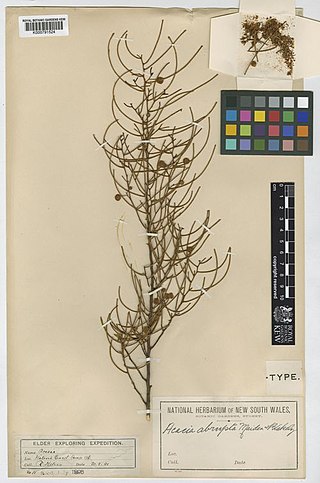
Acacia abrupta is a species of flowering plant in the family Fabaceae and is endemic to arid parts of central and western Australia. It is a spreading, glabrous, resinous shrub with linear phyllodes that are round on cross-section, heads of golden-yellow flowers, and linear pods.

Panopea bitruncata is a species of marine bivalve commonly known as the Atlantic geoduck or Atlantic geoduck clam. These clams like their more famous Pacific relative P. generosa have an enlarged siphon that can extend to great lengths or contract to just barely poke out of the shell. They are generally smaller in comparison to the Pacific species though still constitute a sizable mollusc as they cannot fully retract their siphon.
















